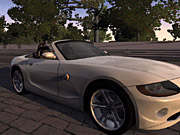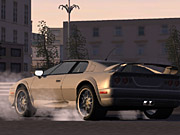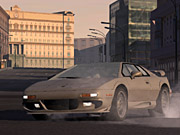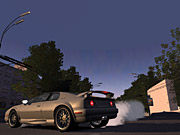Project Gotham Racing 2 Designer Diary #2
The latest in our ongoing series on the development of PGR2 focuses on the planning and research process.
This month, we hear from producer Peter Wallace and senior artists Julie McGurren, Derek Chapman, Paul Spencer, and Mark Sharratt about the planning and research process for Project Gotham Racing 2.
How We Planned Gotham 2 - The Art of Guesstimation
By Peter Wallace
Producer
So, once the team is in place, the planning can begin. This usually starts with myself and Brian (the executive producer) sitting down to look at a blank Microsoft project sheet and jittering! It's a hard task working out the overall plan. Where do you start? Do you start planning in simple terms and then look at detail? Do you look at each aspect individually or just copy the schedule from the last game?

Well, the most important thing is for us to talk to the leaders from each of the groups in the team to help us plan. There are city art, car art, and presentation art groups on the art side, a programming group on the technical side, and a sound group. Each of these has a leader who worked on Gotham, and they have the expertise on how long their tasks will take. However, as the scope and content of Gotham 2 is far greater than Gotham, it's not just a case of doing the same thing over again with the same size team. Over the months leading up to and during the early development on Gotham 2, there was quite a bit of expansion in the team, with carefully picked additions in all areas. There are a total of 15 new people--mainly artists--on top of the original team. Which, combined with the longer timescale, will give a little hint as to the larger scale of the new game.
It may sound odd, but the programming tasks, although the most logical, are the hardest to schedule. You can figure if a task is big or small, but you can't estimate whether each problem will be solved slowly or quickly, and whether there will be five or 500 bugs once it's finished. Also, you're waiting for inspiration, which means that you might try many different ways of doing something before hitting on the right one.
To deal with programmers, we have to throw all their planning instincts to the wind and make a more simplistic plan based on what needs to be done first. For example, without physics, the car handling can't be done, and without a 3D engine, the artists can't view their cities in-game. These tasks are scheduled roughly for the whole game, but then in more detail, as each one gets nearer. This way we know we're roughly on track at any point.

The environment art is more structured, based on an estimate of each area (as they do vary in size). We built in a lot of extra time, and it has been needed, as there's been a lot of extra detail added in on top now. The main tasks in the environments are as follows:
- City research (see below for details).
- Build track surface. This allows initial playability route testing to begin.
- Edit track surface for gameplay. Circuit layouts can be changed to enhance gameplay.
- Block out buildings to help get a feel for what it will look like.
- Gameplay stuff--start and finish lines, AI, routes, and camera setup.
- Build all major buildings, green areas, and runoffs.
- Textures. Objects are textured as we go along, but we have to give priority to licensed textures such as shops, so Microsoft can arrange permission to use them or tell us to change them where needed.
- Finalize track.
- Add barriers where needed.
- Add sound placeholder objects to the scene (such as clock chimes and birds singing).
- Add street furniture.
- Lighting (we start with a daytime setting)
- Optimization. Stop any pop-up, reduce polygons where needed, texture mip bias levels--all the technical stuff to ensure a steady frame rate!
- Nighttime lights and textures.
All this can be estimated pretty accurately, and to date, it's all running pretty well on time (now there's a first!). There's also the presentation to think about. It's something that doesn't often get discussed in game development, but it's an essential part of the game. You could miss whole chunks of the game or key gameplay skills if the presentation and user interface don't do their job correctly.
Schedules are made that cover the main areas of developing a well-presented look and feel to the game. These are:
- Research and look at "what's out there already."
- Initiate concept drawings and rough ideas in a group meeting.
- Start to rough out various concept design layouts.
- Look at what needs to be on every screen, content-wise.
- Apply this to the various initial ideas that have been drafted.
- See if it "works" as a design and get people's views on this.
- Carry through an idea and concept that people are happy with.
- Continue this theme throughout the entire front end.
- Test the ideas through focus groups, and change where necessary.
- Add overall polish and "sparkle" to the look.
And last but not least, the audio. This is split into three areas: cars, environments, and radio. For each car, the list is planned for all the sounds we need and how long it will take to record them, edit samples, and put them in the game. This is then multiplied where necessary--for example, the engine sound changes with each car, but the skid sound doesn't necessarily. All the environments in the game have their own ambient sounds to plan in advance and schedule. The radio sounds are a bit more fluid, as we have to wait for Microsoft to secure the licenses for the stations. Then we can schedule recordings for the DJs--once the script is written, of course--and work out how long it will take to implement them into the game.

As boring as it sounds, scheduling a project this size is essential at the start. We just can't plow straight in there and have everyone working for the sake of it--we'd only end up with wasted work or the project going in the wrong direction. So this planning is done (usually taking up the first month or so, with everyone helping plan their own areas) to make sure we get everything right!
Research Time - Is It Really All Fun in Foreign Places?
By Julie McGurren, Derek Chapman, Paul Spencer, and Mark Sharratt
Senior Artists
This is the bit that all the environment artists probably like the best--the research! We'll start with the research for the circuits and areas that are used in the game. Cars will be covered later, when hopefully we'll be able to give some more details on some of the amazing research that was done for the cars.
The research has been based in a number of areas all around the world. As track artists, we are now experts at long-haul flights and jet lag! The rest of the team is green with envy as yet another e-mail or postcard arrives with "We're in so-and-so place, and it's great!" or "So-and-so is a fantastic place to visit--we're not coming home!" But we are really there to work...honestly! So what goes on when we're researching real locations?
Well, first, before we go, plenty of work is done in research back in the office. Not only do we have to choose which places will be best to include in the game, but we also have to choose which particular locations within the area will reflect this place best. Should we choose a long thin area and make crisscross racing tracks? Or one big rounded area with more possibilities? Which landmarks will people expect to see? Will they know where this building is? Is a visitor to the area likely to visit this place--and if we include it, will the game feel more personal to him or her?
Then it's down to planning each environment in detail using maps--we'll talk about this more later. For the research side, it's best to plan in advance not only where to stay (in the actual area, when possible), but also how to carry out the research. We have so much experience in this now that we can look at an area, say "This will take us around X days to research," and then book a trip of suitable length. Imagine how annoying it would be to book a trip too short, and have to cut down the area, or even go back again just to get a few shots that we missed! And a waste of useful modeling time too!
But before we hop on a plane, the seasonal weather has to be considered! Cold or hot extremes aren't good, and wet weather is bad to research in, as the scenery looks so different in the rain. And (annoyingly enough for working on the tan) sunny weather isn't good, either. When sunlight is casting strong shadows and bleaching out colors, texture shots can't be taken properly. The best conditions are to find a slightly overcast but reasonably bright time of year.
When the plans are made, we get to take off to the exotic locations for the research trips, and we all find it very hard not to refer to them as "holidays." Then again, with the shoe leather that we use up, we soon get reminded that it's work rather than play! But what great work if you can get it--getting to look around the trendiest parts of some of the world's most impressive locations! When we arrive, the first evening or afternoon is usually spent in a taxi or rented car, getting familiar with the area, and checking out the routes we've chosen, and also seeing if there's anything unexpected that might hinder them. For example, during Gotham's development, the Queen decided to do a parade during the research trip down one of the routes, meaning a quick reschedule of research was needed, as the road was closed!

After the initial pass, it's down to business. Three people usually carry out the research together on a trip. One takes general video and photos (generally a researcher rather than an artist), and the other two work methodically down each side of the road. Photos are taken of the general area for reference, and then of each building on its own. Next, detailed shots are taken of each floor or part of the building in order to get good textures from the photos.
It's a meticulous job, and it needs very careful organization. Each film needs to be labeled and cataloged as we go along, as there can be up to 6,000 photographs taken in each area! That's 160 or so rolls of film, so you can see that we need to be really methodical and organized, especially since we usually don't know the area ourselves. Of course, we also need nighttime reference--as if it's not hard enough being on our feet all day with the camera, we also have to spend some evenings getting reference for the nighttime. This is especially important when we're researching areas where the night scenery is dramatically different from the day scenery--in Hong Kong, for example. These shots are used to make separate nighttime textures for the scenes, as the lighting in most places is so different at night that we will have to use a completely different textured model in the game.
Of course, we do get to take some evenings off to sample the local culture. For example, we did manage to time our Hong Kong trip with the Chinese New Year--no research shots got taken that night! It's not always fun, though. Perhaps we'll be allowed to tell you in a later diary about the time when one of the research teams was suspected to be a group of terrorists, and detained and interrogated. At the end of the trip, we pack up and head back to the office for the long and detailed task of modeling the environments while fighting off the jet lag. More to come on that soon!
Got a news tip or want to contact us directly? Email news@gamespot.com
Join the conversation